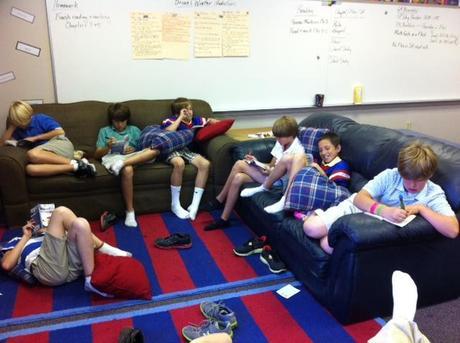At seven p.m., right after watching Sesame Street, I put on my PJs, brushed my teeth, washed my face and patiently waited under the covers for my mom to come upstairs to read to me. Almost every week I got to pick a book – first from the shelf and not much later from the local library – that she would read to me at bed time. When I was about six years old I could read a couple of myself before I went to sleep.
I have always loved stories. I loved it when my mother read to me and I loved it when the teacher did in class. Every Wednesday afternoon, my mother would take me to the library and I would just pick the books off the shelves one by one until I found one I really felt like reading. The library also felt like a kind of safe haven; it was one of my favorite places. I favoured reading about children that were about my age or maybe even a bit older, animals and faraway places. By devouring many books, however, I have broadened my tastes somewhat. I never lost interest in reading, even as I was hitting puberty. On the contrary, I loved losing myself in a good story at that time.
Now I teach adolescents at the lower levels of Dutch secondary education. I teach them English, and the books they need to read for me are thin and contain lots of pictures. Most pupils are reluctant to read even those. Admittedly, these books are very simple and rarely contain an enticing plot line. I also hear a lot of them complaining about having to read Dutch books. I think that in their first and second year they need to read a total of 6 books. When I ask them what they don’t like about reading, their cut-and-dry answer is that they think it’s boring. When I ask them why they think reading is boring, they don’t really have an answer ready.
I, however, think reading is important for a number of reasons. For starters, a lot of our students enter secondary education without having reached the required level of technical reading. This means that they are sometimes still struggling putting sounds to letters, reading full stops and question marks, and reading sentences with (the intended) intonation. If the basics of reading take this much effort, I can imagine that those students don’t get to lose themselves in a story. Sometimes I ask them after reading one paragraph to tell me what that paragraph was about, and I lost count of how many times the students were able to do this.
Another well-known fact tells us that reading has the positive side-effect of expanding our vocabularies. Research has shown that we need to know the meaning of 95% of all the words in a text in order to properly grasp the meaning of that text. So when a student’s vocabulary is insufficient for understanding a text, the student will most likely not understand the text and stop reading. Unfortunately, when that student stops reading, he or she also takes away one of the most important sources for vocabulary acquisition.
I have read countless books that took me from dreary Holland to the most exotic places. I could be a fly on the wall in the home of a minority family. I was practically there as a girl about my age was physically abused. Reading did not only improve my technical reading skills and vocabulary, it also showed me what the world was like outside of my own personal living environment. Reading taught me about the world around me. Furthermore, through reading you get the privilege to live inside of someone else’s head for a while. You experience everything with your protagonist and you see what this character is going through, thinking and feeling. This enables us to empathise. Empathy, being able to understand where someone is coming from, is something that should be fostered in our students. Reading could be a beautiful way to do this.
Everything in society is becoming faster, short-lived, fleeting. My students have to be in contact with each other almost 24/7 (illustrated by sleeping with their mobile phones under their pillows). They watch fast-paced TV programmes, play video games, ping and tweet, and listen to predominantly high-speed music. They don’t want to make time for something requiring a longer attention span, like reading. On top of that, reading is something that is being obligated by many teachers, which doesn’t make reading even remotely more attractive. I don’t know whether you remember being an adolescent, but I strongly recall hating everything I had to do, even when I secretly liked doing it. So, we simply need to remove that pressure.
A lot of (young adult) books have been written – with the best intentions – by authors who take small pieces of their own childhood and adolescence and weave a story from those experiences planting the now popular but then non-existent mobile phones and social media randomly in their narratives. This could make the story seem not as real as it was intended to be, and may estrange young readers. We should not bother our reluctant readers with works we deem suitable. We should look at their interests and present them with reading materials that match these interests. These reading materials don’t necessarily have to be young adult books, but could also be magazines, comic books or non-fiction. The primary goal is to get them to start to like reading and to be open to it.
Reading in a classroom can be really uncomfortable. When I read at home, I like to curl up on a couch or a comfortable chair with something to eat or drink. Except when I’m seriously studying, I never read at my dining room table. Creating an environment that gives off a homey and comfortable vibe and actually is homey and comfortable could be a key ingredient to getting our students to start to like reading. By making reading something recurrent, it can become normal and not something that only ‘nerds’ do. Reading silently for about twenty minutes three times a week in a comfortable room, might just do the trick.
Reading is often seen as a solitary activity, and adolescents like to do stuff together. This is why it is probably important to make reading into something that can be interactive too. Through activities students can be encouraged to share their likes and dislikes and their experiences reading; their thoughts on certain characters or places. Who knows, they might even prompt each other to read certain books.
Much to my surprise (and secret dismay), I have discovered that quite a few of my colleagues don’t like reading either. How can we expect our students to read books, when we don’t pick up a book, magazine or newspaper ourselves? Therefore, when the students are silently reading their books, don’t sit behind your desk and start correcting tests. Grab whatever text does have your interest and read with them. Your job can be this easy!
I think we have a lot to think about when it comes to making readers of our students. I have a slight suspicion that a little bit of fear comes into play here as well. When introducing reading as a recurring activity throughout the school week, we will be undoubtedly confronted with some opposition from our students. But just like they need to give reading a chance, we need to give them a chance to grow used to it and start liking it. We simply need to bite the bullet, stop being afraid and start trusting our kids. We probably won’t get them all, but each one we do get, counts.

